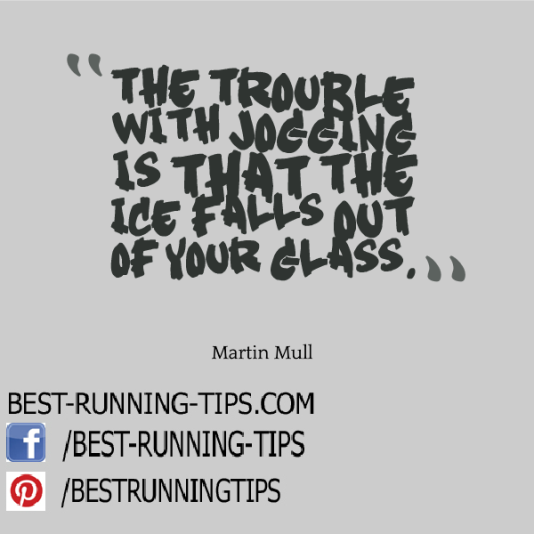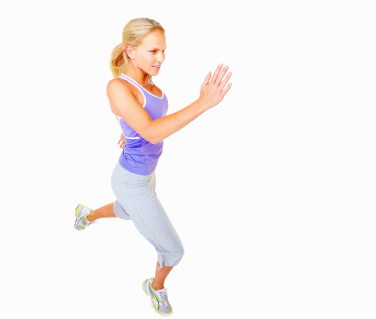Heart Rate Monitor Running Programs
10k Running Program and 1/2 Half Marathon Training Schedule Guaranteed to Bring Results
Heart Rate Monitor Running Programs are running programs in which the speed of your runs is determined by your heart rate.

First of all, you can always get one :)
Have a look at the most important features of heart rate monitors to find out what to look for in a heart rate monitor.
Secondly, I will explain which heart rate zone corresponds with which type of running.
So you could even use these heart rate monitor running programs without wearing an actual heart rate monitor.
In this section I will provide you with two training schedules:
Not quite at that level yet? Then check out the run/walk beginner running programs.
Work your way up to running 30 minutes non-stop, e.g. by using Beginners Running Program 3 (from 0 to 30 minutes of non-stop running in only 12 weeks), then move on to the 10k running program.
Once you have finished that, move on to the half marathon running program.
I get e-mails from people who have gone from zero to half marathon all via the running programs on this site!
Goal of These Heart Rate Monitor Training Programs
These heart rate monitor running programs are focused at those runners wanting to finish their first 10K or half marathon. These training programs will get you to the finish, but they are not aimed at racing the distance.
Notice that subtle difference?
By all means, enter a race. In fact I encourage you to do so. Because when you have a race scheduled, your motivation to stick to the running plan is definitely higher.
But do not race your race.... "only" finish it... enjoy it... after your first, hopefully successful attempt to finish a race you will have many opportunities to improve your performance.
When you are relatively new to running, it really is best to take things one step at a time. You have got a lifetime of running ahead of you. So, first focus on being able to cover the distance, being able to run that far.
Then next time, try to improve your running with a training schedule focused on improvement.
That's why you don't find any real speedy stuff in these running programs. Pretty much all runs will be focused on improving your aerobic performance. So, getting you used to the time on your feet and the distance you have to cover in your race.
The Heart Rate Monitor Training Zones
These heart rate monitor running programs cover four heart rate monitor zones:
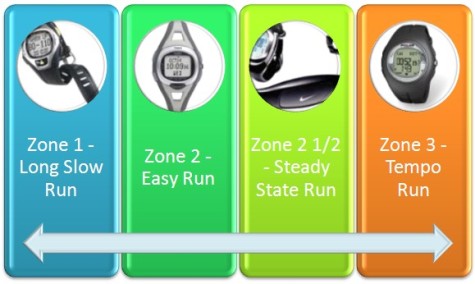
Determining Your Heart Rate Zones
You can determine your heart rate zones in different ways. To determine your heart rate monitor training zones I refer to the following two pages:
So How Fast Are Those Zones Exactly?
A slow run is slower than anything you have experienced before. Some people label it as one to two minutes per mile slower than marathon pace.
I find that difficult.
I rather use the following description:
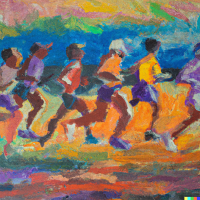
An easy run is the pace at which you could still maintain a conversation. That's why it is also known as conversational pace.
A steady state run hmm, pretty hard to describe until you actually feel it. Start using these heart rate monitor running programs and you'll find out... Anyway, just that little bit faster than easy pace, I guess, but not as fast as tempo pace.
A tempo run is described as the pace you can go for an hour. So it feels harder than an easy run, and it is a bit faster, but not that fast that after ten minutes you feel you can't go anymore. It needs to be tough, but not so tough that it will force you to slow down after 5-10 minutes.
You see, it is difficult to make this very clear in words. That's why it is so good to have a heart rate monitor when you are using these heart rate monitor running programs.
Your heart rate monitor will guide you on how fast you should go, and then you feel what it is like to run at that pace.
I don't use my heart rate monitor to guide my pace that often nowadays. Because now I know how fast a tempo run is and what it feels like. I know how fast my slow runs go. But I thank my heart rate monitor for the beginning months and years when I did not have a clue on how fast to go!
Hey, How About The Speedwork?

There is a popular school of thought that for the first 3-4 years of running, all running should be easy and slow running.
Yeah, maybe, but that's not very exciting..!
I don't know a runner who has actually done that so they can prove that it is way more beneficial!
Sooner or later, everybody wants speed.
And it can be argued that these running programs should have an element of speedwork.
I feel, however, that it is better to get you ready to cover the whole distance by focusing more on the slow and easy running with the occassional steady-state and tempo run in between.
I think that tempo runs and steady-state runs serve their purpose in improving your lactate threshold and improving your aerobic profile.
And at least, they offer you that little bit of extra variety which keeps your heart rate monitor running programs fun and doable!
Training Blocks
Your heart rate monitor running programs consist of three four-week-blocks:
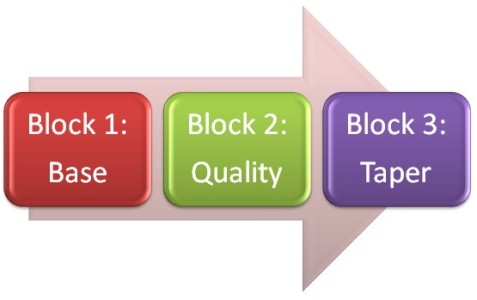
Cutting down your training in blocks like these is called periodization.
Within these blocks, each fourth week is a rest week in which training is cut back.
The purpose of this is to refreshen you and get you ready for the next phase.
Do cut back your training every fourth week.
Famous female Dutch cyclist Leontien van Moorsel stopped cycling a few years ago and started training for the New York marathon (for fun, not in a bid to win the race).
Just before her marathon she was interviewed by Dutch television and was asked what the big differences where between bicycle training and running training.
She described it very well, when she said that running training was all about resting. She could not believe in the beginning how much rest runners took.
But after a while she saw that hard days every day is not very beneficial for your running.
You need your easy days.
You need your rest weeks.
Should Runners Do Cross-Training?

Cross-training is good for you! Check out my cross training for runners page with more thoughts on this interesting subject.
Warming Up?
I have collected my thoughts on warming up and cooling down on the running stretches page.
In addition to a dynamic warm-up (see the link mentioned before), when you do a run in Zone 1 or Zone 2, you do not really need to warm up. As long as you keep to the pace, the first 5 to 10 minutes serve as a good enough warming up.
Going faster than conversational pace? Then definitely do a warm up through an easy start!
Suppose you have a 40-minute Zone 2 1/2 run planned. Then run the first 5 to 10 minutes in Zone 1 and/or 2 and the remainder of your run in Zone 2 1/2.
Have a tempo run planned? Then before you get into serious Zone 3 action, also run your first 5 to 10 minutes in Zone 1 or 2. Then start with your Zone 3 intervals.
Cooling Down?
Finish your run with a few minutes of easy running. A good habit to develop is to finish up with 4 to 8 strides (also called striders). Strides are relaxed sprint efforts of 50 to 100 metres. You build up slowly, go faster and faster until you reach close to top speed for a couple of seconds and then you let yourself unwind.
You can read more about strides here.
Disclaimer
Only use these heart rate monitor running programs if you are already trained.
Before starting the 10K running program, make sure you can run for half an hour non-stop.
Before starting the half marathon running program, make sure you can finish a 10K.
Even then, when in pain, stop.
I cannot coach you from a distance, so I cannot judge whether you are pushing yourself too hard or not.
These running programs are set up well and use a slow but steady approach to help you achieve your goals. They are perfectly fine for most runners.
But you have to use your own judgement here. In other words, if you get injured don't blame me.
OK, now that's all out of the way, below are the links to the heart rate monitor running programs and the beginner run/walk programs.
Enjoy and good luck!
Home > Heart Rate Monitor Training > Heart Rate Monitor Running Programs
